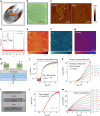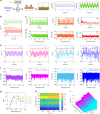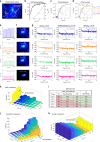Stochastic resonance in MoS2 photodetector
- PMID: 32879305
- PMCID: PMC7468142
- DOI: 10.1038/s41467-020-18195-0
Stochastic resonance in MoS2 photodetector
Abstract
In this article, we adopt a radical approach for next generation ultra-low-power sensor design by embracing the evolutionary success of animals with extraordinary sensory information processing capabilities that allow them to survive in extreme and resource constrained environments. Stochastic resonance (SR) is one of those astounding phenomena, where noise, which is considered detrimental for electronic circuits and communication systems, plays a constructive role in the detection of weak signals. Here, we show SR in a photodetector based on monolayer MoS2 for detecting ultra-low-intensity subthreshold optical signals from a distant light emitting diode (LED). We demonstrate that weak periodic LED signals, which are otherwise undetectable, can be detected by a MoS2 photodetector in the presence of a finite and optimum amount of white Gaussian noise at a frugal energy expenditure of few tens of nano-Joules. The concept of SR is generic in nature and can be extended beyond photodetector to any other sensors.
Conflict of interest statement
The authors declare no competing interests.
Figures




References
-
- Wiesenfeld K, Moss F. Stochastic resonance and the benefits of noise: from ice ages to crayfish and SQUIDs. Nature. 1995;373:33. - PubMed
-
- Nicolis C. Long-term climatic transitions and stochastic resonance. J. Stat. Phys. 1993;70:3–14.
-
- Benzi R, Sutera A, Vulpiani A. The mechanism of stochastic resonance. J. Phys. A: Math. Gen. 1981;14:L453.
-
- Douglass JK, Wilkens L, Pantazelou E, Moss F. Noise enhancement of information transfer in crayfish mechanoreceptors by stochastic resonance. Nature. 1993;365:337. - PubMed
-
- Russell DF, Wilkens LA, Moss F. Use of behavioural stochastic resonance by paddle fish for feeding. Nature. 1999;402:291. - PubMed
Publication types
LinkOut - more resources
Full Text Sources
Research Materials

